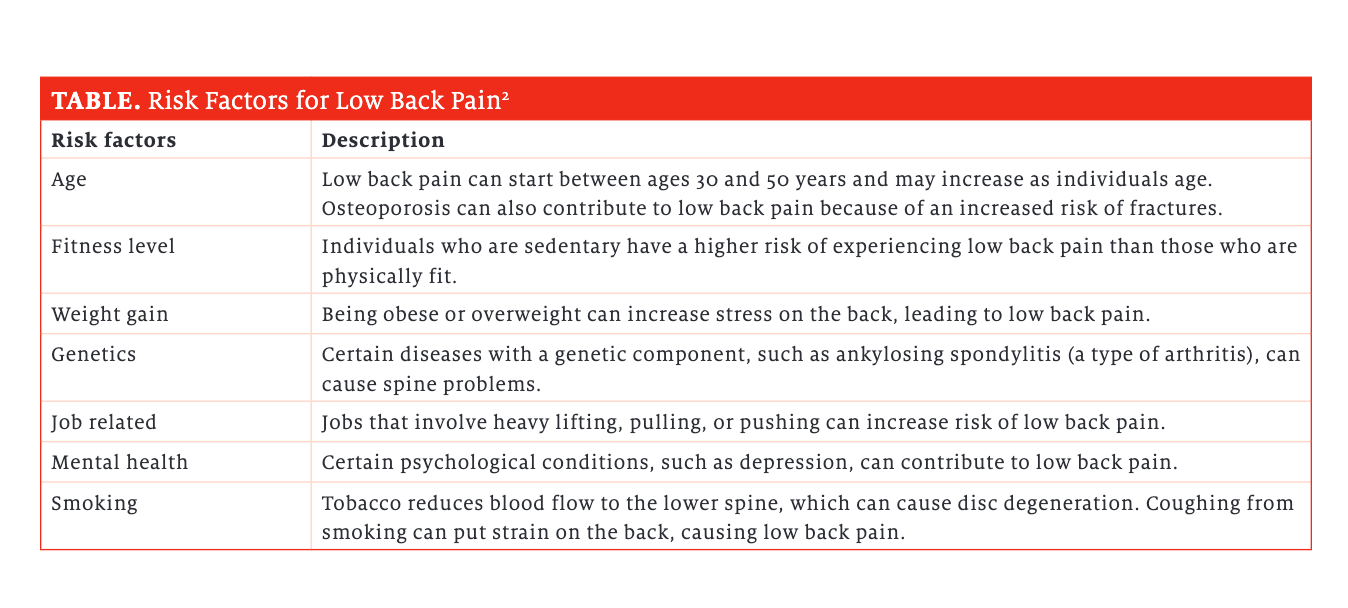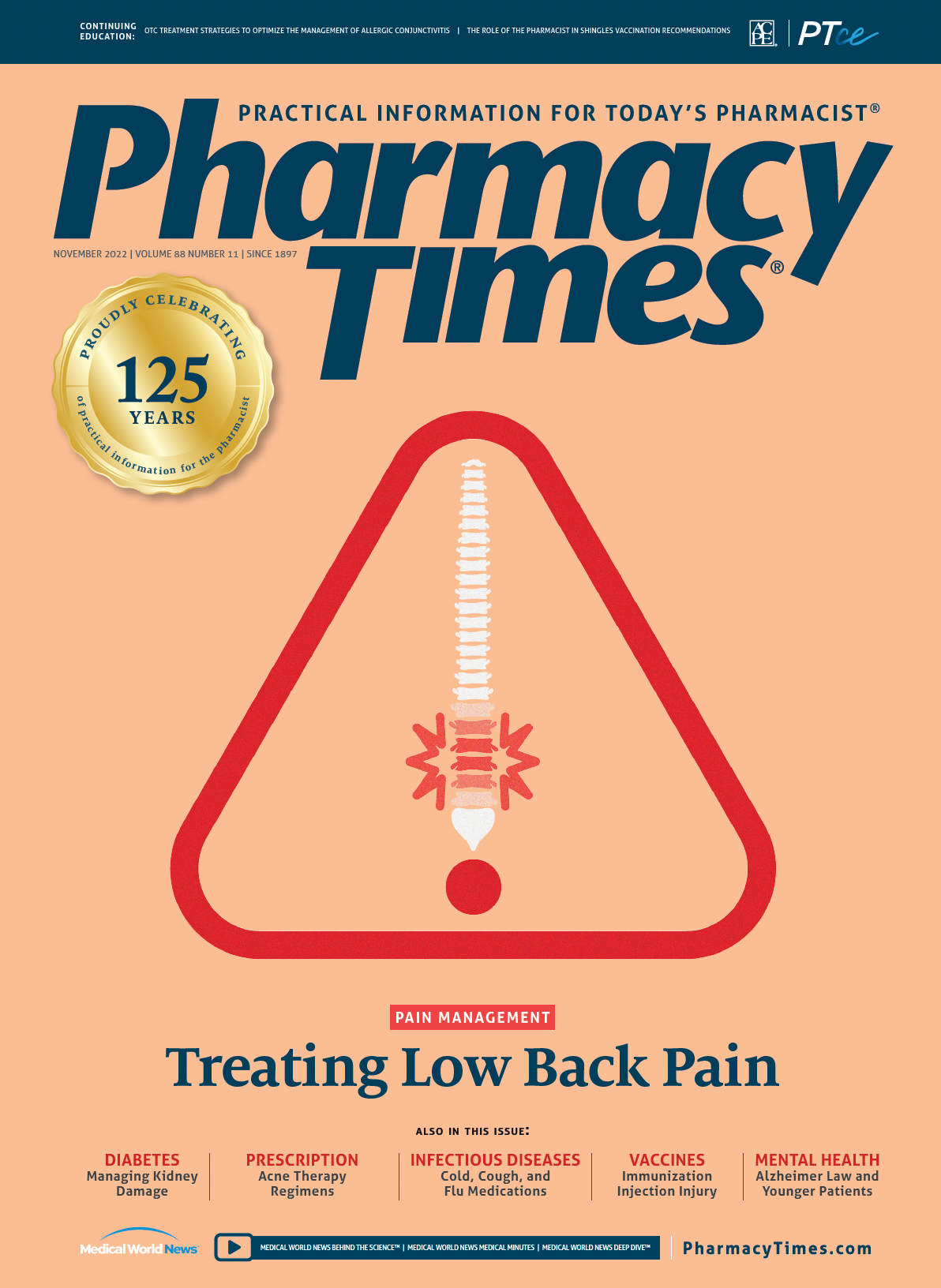Publication
Article
Pharmacy Times
Help Patients Manage Low Back Pain, Risk Factors
Author(s):
Pharmacists can offer advice on nonpharmacologic and pharmacologic prevention and treatment strategies.
Low back pain is a common musculoskeletal condition globally, as well as one of the top causes of limitations to physical activity. The prevalence of individuals with low back pain increased to 577 million individuals in 2017 from 377.5 million in 1990, according to data from the 2017 Global Burden of Disease study.1 There are a variety of nonpharmacologic and pharmacologic strategies to alleviate low back pain.
Risk Factors, Prevention
There are a variety of risk factors for developing low back pain (Table2), and many of these are modifiable. Pharmacists can play a key role as part of an interdisciplin-ary team to educate patients about these risk factors. Pharmacists can recommend that patients exercise regularly to prevent low back pain. Individuals should wear comfortable low-heeled shoes and use ergonomically designed furniture and equipment at home and work.2 Individuals should also avoid lifting objects that are too heavy. Implementing a nutritious diet that includes calcium, phosphorus, and vitamin D and maintaining a healthy weight are also important strategies.2 Pharmacists can also recommend nicotine replacement therapy products to help patients quit smoking.

Pharmacists' Role
There are 2 types of low back pain: acute and chronic. Acute low back pain typically lasts a few days to a few weeks2 and generally resolves on its own with self-care. Chronic low back pain continues for at least 12 weeks.2 Approximately 20% of individuals affected by acute low back pain develop a chronic condition.1 The US Department of Defense (DoD) and Department of Veterans Affairs (VA) clinical practice guidelines recommend exercise programs, such as aerobic, strengthening exercises, structured walking programs, and tai chi, as nonpharmacologic therapy for managing low back pain.3
Heat and/or ice may alleviate acute pain by reducing inflammation.4 Heat can be applied for 15 to 20 minutes using baths, hot packs, or showers.4 If patients are using an electric heating pad, it is important that they avoid falling asleep while it is turned on to prevent burns.4 Setting a timer can also help ensure that heat is not applied for more than 20 minutes at a time. Ice can also be applied for 15 to 20 minutes at a time to help alleviate pain.4 Alternating between cold and heat is another option to manage low back pain. Patients can try heat for 15 to 20 minutes, followed by ice a few hours later for 10 to 15 minutes.
Acupuncture may be beneficial for patients with chronic low back pain as an alternative and complementary therapy.3 However, there is insufficient evidence to recommend for or against acupuncture for acute low back pain.3 The DoD/VA low back pain practice guidelines recommend against opioids for managing chronic low back pain, as the potential risks outweigh the benefits.3 OTC nonsteroidal anti-inflammatory drugs (NSAIDs), such as ibuprofen (Motrin) or naproxen (Aleve), can be used for managing acute and chronic low back pain.3 The dose of ibuprofen is 400 mg every 4 to 6 hours, with a maximum daily dose of 3200 mg per day.3 The dose of naproxen is 250 mg twice daily, with a maximum daily dose of 1500 mg per day.3 Evidence shows that NSAIDs are associated with a 30% reduction in pain or combination of pain reduction and functional improvement compared with the placebo.3
However, NSAIDs may not be the preferred choice in older adults or patients with cardiovascular (CV) or gastrointestinal (GI) risk factors,3 as they carry a boxed warning of an increased risk of CV and GI events.3 The FDA strengthened the warnings section for nonaspirin NSAIDs regarding the increased risk of myocardial infarction and stroke.5 Therefore, it is best to use NSAIDs at the lowest dose for the shortest duration possible to reduce this risk. Naproxen may have a lower CV risk than other NSAIDs.3 It is important for pharmacists to advise patients that NSAIDs can also cause renal impairment, as they may cause sodium and water retention and increase serum creatinine.3
Duloxetine (Cymbalta) 60 mg once daily is an effective treatment for patients with chronic low back pain.3 It is a serotonin norepinephrine reuptake inhibitor that is often used to manage depression and generalized anxiety disorder. Additionally, evidence has shown that duloxetine is effective for managing chronic neuropathic pain and fibromyalgia.6 One systematic review of randomized placebo-controlled trials examined duloxetine for the treatment of chronic low back pain.6 There were 5 studies evaluated that met the exclusion and inclusion criteria. Studies included 1540 patients treated with duloxetine (832), placebo (667), or both duloxetine and placebo (41) in a crossover analysis.6 Study participants were initially started on duloxetine 30 mg daily, and the dose was increased to either 60 or 120 mg daily.
All 5 of the placebo-controlled, randomized tri-als reported statistically significant improvements in more than 1 back pain specific clinical outcome score with duloxetine vs the placebo.6 The duloxetine 60-mg daily dose was effective, and patients experienced fewer adverse effects (AEs) than with the 120-mg daily dose.6 Pharmacists should edu-cate patients about some common AEs associated with duloxetine, including diarrhea, dizziness, dry mouth, fatigue, headaches, insomnia, and nausea. Future randomized controlled trials are still needed to assess for efficacy and safety of duloxetine for chronic low back pain.
About the Author
Jennifer Gershman, PharmD, CPh, PACS, is a drug information pharmacist and Pharmacy Times contributor who resides in South Florida.
References
1. Wu A, March L, Zheng X, et al. Global low back pain prevalence and years lived with disability from 1990 to 2017: estimates from the global burden of disease study 2017. Ann Transl Med. 2020;8(6):299. doi:10.21037/atm.2020.02.175
2. Low back pain fact sheet. National Institute of Neurological Disorders and Stroke. Updated July 25, 2022. Accessed October 15, 2022. https://www.ninds.nih.gov/low-back-pain-fact-sheet
3. VA/DoD clinical practice guideline for the diagnosis and treat-ment of low back pain. Department of Veteran Affairs. February 2022. Accessed October 16, 2022. https://www.healthquality.va.gov/guidelines/Pain/lbp/VADoDLBPCPGFinal508.pdf
4. Use heat or ice to relieve low back pain. Kaiser Foundation Health Plan, Inc. March 9, 2022. Accessed October 18, 2022. https://healthy.kaiserpermanente.org/health-wellness/health-encyclopedia/he.use-heat-or-ice-to-relieve-low-back-pain.hw47901
5. FDA drug safety communication: FDA strengthens warning that non-aspirin nonsteroidal anti-inflammatory drugs (NSAIDs) can cause heart attacks or strokes. Updated February 26, 2018. Accessed October 17, 2022. https://www.fda.gov/drugs/drug-safety-and-availability/fda-drug-safety-communica-tion-fda-strengthens-warning-non-aspirin-nonsteroidal-an-ti-inflammatory
6. Hirase T, Hirase J, Ling J, et al. Duloxetine for the treatment of chronic low back pain: a systematic review of randomized placebo-controlled trials. Cureus. 2021;13(5):e15169. doi:10.7759/cureus.15169There

Newsletter
Stay informed on drug updates, treatment guidelines, and pharmacy practice trends—subscribe to Pharmacy Times for weekly clinical insights.





